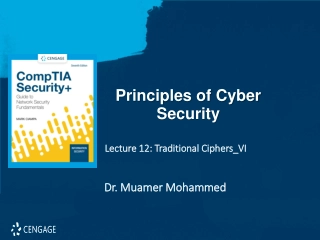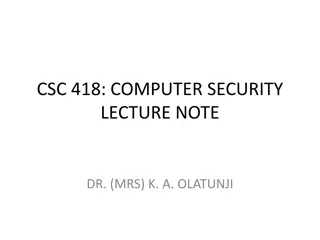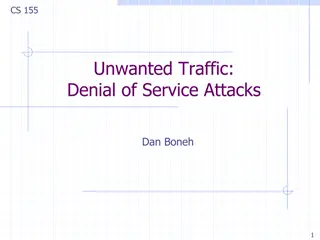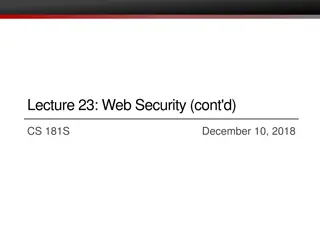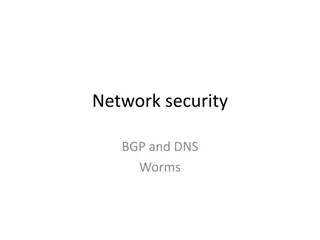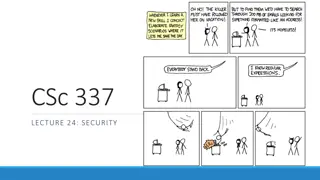Understanding Network Security Fundamentals and Common Web Application Attacks
Learn about the basics of network security, including common web application attacks such as Cross-Site Scripting (XSS), SQL Injection, and Session Hijacking. Explore important concepts like cookies, markup languages, and ways to enhance security to protect against cyber threats.
Download Presentation

Please find below an Image/Link to download the presentation.
The content on the website is provided AS IS for your information and personal use only. It may not be sold, licensed, or shared on other websites without obtaining consent from the author. Download presentation by click this link. If you encounter any issues during the download, it is possible that the publisher has removed the file from their server.
E N D
Presentation Transcript
Network Security Network Security Fundamentals 2 Fundamentals 2 Carrie Estes Collin Donaldson
Application Attacks Zero day attacks zero day Web application attacks Signing up for a class Hardening the web server Enhancing the security May not prevent against web attacks Protecting the network Traditional network security devices can block traditional attacks, but not always web app attacks
Cross-Site Scripting (XSS) Injects scripts into a web app server Direct attacks at clients Does not attack web app to steal content or deface it Victim goes to website, instructions sent to victims computer, instructions execute Requires two criteria It accepts input from the user without validation It uses the input in a response without encoding it
SQL Injection Structured Query Language View and manipulate data in a relational database Targets SQL servers Attacker using SQL would braden.thomas@fakemail.com If Email address unknown pops up, entries are being filtered If Server failure pops up, entries are not being filtered
Markup Languages A markup language is a method for adding annotations to the text so that the additions can be distinguished from the text itself HTML is also a markup language It uses tags embedded in brackets so the browser can format correctly Extensible Markup Language XML carries data and tags are user made XML and SQL injection attacks are very similar A specific type is Xpath injection Attempts to exploit XML Path Language queries that are built from user input
Cookies First Party Cookie Persistent Cookie Third Party Cookie Secure Cookie Session Cookie
Session Hijacking An attack in which an attacker attempts to impersonate the user by using his session token. An attacker can eavesdrop on the transmission to steal the session token cookie. A second option is to attempt to guess the session token cookie. Session Token: A form of verification used when accessing a secure web application.
Buffer Overflow attacks A buffer overflow occurs when a process attempts to store data in RAM beyond the boundaries of a fixed-length storage buffer. Attackers use buffer overflow to compromise a computer.
Network Attacks Denial of Service: Makes attempts to keep a computer from performing its normal functions. DDOS attack: Uses multiple computers. Ping flood: Uses the ICMP to flood the victim with packets. The computer is overwhelmed and cannot respond quickly enough. This causes it to drop legitimate connections to other clients. Smurf attack: An attack that broadcasts a ping request to all computers on the network yet changes the address from which the request came to that of the target.
Man in the middle attack Angie is a high school student She is doing poorly in math class Her teacher sends her parents a letter Angie waits for the letter and replaces it with a different letter Her teacher wonders why her parents do not respond to having a conference.
Vulnerability Assessment Asset Identification Threat Evaluation Risk mitigation Diminish the risk Transfer the risk Accept the risk





